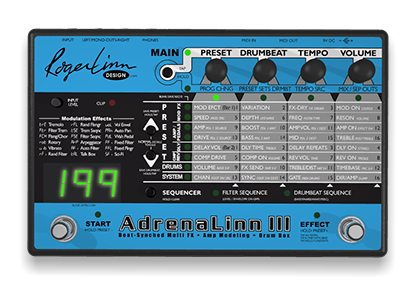This is a continuation of the Adrenalinn III pedal review, you can see the previous installment here. This time, we’re going to look at the pedal’s effects, i.e. delay, reverb, compression, and modulation. The reverb and delay are pretty basic, so we’ll spend most of our time looking at the spectacular modulation effects. If you’re a fan of John Mayer, you’ve probably heard this pedal’s modulation- it’s the pedal he uses on the songs Bigger Than My Body, Heartbreak Warfare, and I Don’t Trust Myself.
The way the pedal routes the signal internally can be changed to a certain extent: you can change the order of Amp, Mod, and Compressor in the chain. Delay and Reverb always come last (partly because you can also route the drum machine through delay/reverb). The compressor can be used pre-amp as a sort of clean boost, or after as a limiter.
Delay can be set for either a specific time (up to 2.8 seconds) or a subdivision/note value driven by the MIDI clock. This means not only can you set the song’s tempo by tapping a footswitch, you can also master/slave that tempo with other equipment using MIDI. This functionality works with the modulation effects as well. Delay has Mix, Time, Repeats, Treble, and Stereo controls. The total delay time won’t go over 2.8 seconds, so if you set it to “2 measures” and the tempo is below 173 BPM, it will switch to the next shortest time, i.e. 1 measure. However, it will do subdivisions of beats (including triplets) all the way down to 32th note triplets.
The delay is actually very nice sounding, especially if you use the Treble rolloff. It doesn’t have reverse, modulated, or granular modes, it’s just a no-frills time-synced delay. I found it very usable, especially for that popular “U2” dotted-eighth sound. Very precise, smooth, and unintrusive. Even at extreme length and repeats, it doesn’t break up or act funny.
The delay’s stereo control pans the delay signal to one side, leaving the dry signal on the other side. My biggest gripe with this is that when you turn the delay off, it goes back to dry signal in both channels. So if you’re wanting to run a wet/dry setup, this might not work. A possible workaround would be to map a MIDI control to turn the delay’s volume to zero instead. (more on the stereo setting later)
The Reverb effect is also very basic, with only Mix, Time, and Treble controls. It’s able to go from a bright plate-like reverb, to deep, dark ambient hall swirls. I mostly use it for “room” style presence, because I run the pedal straight to a sound board, but it’s capable of a lot more depth than that.
When set to full depth (and the treble rolled off), the reverb is just about enough for ambient swirly sounds, but again, you’re not going to get any modulation, shimmer, or any of that stuff from it.
Note: Something interesting I found in the manual is that if you use Reverb and Delay at the same time, then Delay is limited to 700ms, partly because the Reverb effect uses some of the memory. It also switches either effect on or off, or drops delay time to a shorter subdivision automatically, depending on which effect was turned on or adjusted last. In practice, it’s not a huge problem unless you’re wanting to go for super-deep ambient stuff. I didn’t even notice it. But if you’re looking for a off-the-deep-end sound, you’ll probably want to run a separate reverb or delay (or both) afterwards in the chain. I *do* run a separate reverb pedal for very deep modulated reverb. I use the Linn’s reverb for everything else. As it is, I’m very happy with the Delay/Reverb for normal playing.
The Modulation effect, however, is the crown jewel of this pedal, no bones about it. The manual says:
“Tremolo, flanging, chorus, auto-wah, talk box, auto-pan, rotary speaker and vibrato, but also new effects like random filtering or flanging and AdrenaLinn‘s innovative filter, tremolo and arpeggio sequences. All modulation effects can play in sync to the drumbeat or to MIDI clock.”
There’s also a “Sci-Fi” setting. Basically, the Mod effects can be divided into 3 groups: Pitch, Volume, and Filter.
Volume effects include tremolo, volume envelope, and sequenced tremolo, which lets you do 16-step hard-panned DJ-style stutter effects, much like the Boss SL-20. The Tremolo can also use attack/decay variations, which can go from synth-like slow rises to saw waves, to off/on stutter. Of course, everything is synced to the MIDI clock, so you can get perfect tremolo subdivisions. The Volume Envelope reacts to your pick attack, which works much like the fabled Boss SG-1 Slow Gear or Mu-Tron. Combined with a filter, it gets really close to an old Moog synthesizer sound.
Pitch effects include Flanger/Chorus, Vibrato, Rotary, and the Arpeggiator (which is what John Mayer uses on “Bigger Than My Body”). The Chorus/Flange effect is fairly traditional, but comes in Fixed, Random, or Synced varieties. Vibrato is basically like chorus, but without the delay or phasing. You can do some extreme pitch bending (the rubber band strings trick is hilarious), or have it do a nice, smooth vibrato. Rotary is similar to Chorus, but with a bit of volume modulation thrown in to make it (sort of) sound like a Leslie speaker cabinet.
The biggest complaint I have with the modulation effects is the stereo setting. I was hoping that it would do nice lush rotary and chorus sounds, with real stereo processing. (I use an analog stereo chorus amp, I’m kind of spoiled.) But what I discovered is that to save processing power, the stereo modulation effects are mono effects run through a stereo panning effect. Of course, everything’s time-synced, so it sounds pretty convincing. But running it through a stereo amp, you can tell the difference. (more about the stereo setting later)
The Arpeggiator is really the creme’ de la creme’ of this pedal. Per the manual:
“This effect definitely pushes the weird/cool lever to the limit. It accentuates specific musical notes in 2 measure patterns. Even if you play muted strings on the guitar, you‘ll still hear the generated note sequence because the sequence‘s notes are actually generated in response to your playing. The note sequence is fixed and does not change depending on what you play. You can choose one of 20 preset arpeggiator sequences—a variety of major, minor, seventh and other patterns—or create your own.”
Now, granted, this is kind of a “special use only” thing. You wouldn’t want to make a whole album with this effect! But it’s stunning when used correctly. Also, the filter’s transposition can be changed with incoming MIDI notes… i.e. you can change the key signature by hitting a key on a MIDI keyboard (the factory presets are all in “E”). You can do some crazy stuff with this, especially if you’re into 80’s synth-rock.
Stereo Setting Note: the pedal has one input and two outputs. The outputs do different things depending on what settings you use.
For instance, the default setting is to combine the drum machine and guitar effect outputs. But you can also set the outputs to “separate” which puts all guitar sounds on the left channel and all the drums on the right, so you can run them into separate amps or mixer channels. (This is what I do.)
Another interesting thing I discovered was that with effects that have a “stereo” parameter, such as delay, chorus, or tremolo, it will only work in stereo under certain circumstances, and only in certain ways. The delay is not a true stereo delay, it’s simply a single delay that you can split out to wet/dry outputs.
If you set the Delay effect to full stereo, it will have the plain mono (dry) signal on one side, and the delayed sound (wet) on the other. But you cannot combine stereo panned modulation and delay effects. One essentially cancels out the other, and once you realize why, it makes sense- if you use a tremolo that pans back and forth (left/right), then running that into a wet/dry delay pedal has to combine it back to mono, then delay the signal and split it again- so you end up nullifying the panning tremolo anyway. (Remember what I said about the mod effects being mono going through a panner? This is why it’s a problem- it doesn’t work with wet/dry delay.)
If you want to run true stereo delay (ping-pong, etc) after stereo modulation, then you’ll have to buy a pedal just for that. And in all honesty, this is probably what I’m going to end up doing. You can get a BOSS or TCE stereo delay pedal that has more delay types, and true stereo separation, if that’s what you want. They’re extremely affordable options. However- you may not need that level of advanced delay. If you just need some slapback echo, or some wet/dry digital delay, or even a really nice mono delay, then the internal delay effects works great.
And if you’re using the onboard drum machine output separately, then all the guitar effects will be in mono anyway. If you run any pedals after the Linn AND want to use the drums, then this is the route to go.
Conclusion: Because I run my amp in stereo AND use the drums, I have separate stereo reverb/rotary/delay pedals, and I run the Linn in mono/separate mode. If I wasn’t doing ambient sounding stuff, then I would just use the Linn by itself- it’s very capable on its own as an all-in-one solution, if you don’t need extreme reverb or delay types. The amp models are very good. The filter-tremolo-modulation effects are fantastic. Plus it has a headphone out jack for practicing. If I were doing a classic rock cover band, this pedal would be all I needed- and that’s not an exaggeration.
However… there are definitely things I would improve on it if Roger Linn were to release a new version of it (which he’s said he isn’t, but you never know). I’d love to see:
- Four buttons instead of two
- USB midi (for programming it without having to re-wire your board’s MIDI cables)
- Separate output for drums
- The input level knob with detents, or a bigger knob (it’s really fidgety to set)
- True MIDI-through
Coincidentally, most of these problems could be solved with an add-on Arduino mini board inside the case. Hmm….
Overall, for the price and feature set, it’s a fantastic pedal. I highly recommend it as an alternative to the Line6 HX Stomp and the like. The Adrenalinn III is much cheaper, and has a robust set of features for most types of music.

